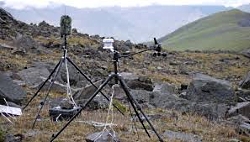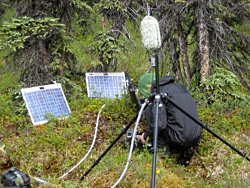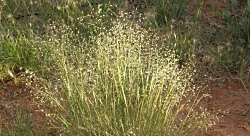
Courtesy US NPS

Courtesy US NPS
Noise pollution significantly impacts human health. Physical and mental impacts can include hearing disorders, sleep disruption, and even interruptions in the cardiovascular and endocrine systems. Sound is more important than you might realize.
Soundscapes may be important to humans, but they are arguably even more important for wildlife. Many animals depend on hearing for warning them of danger, communicating with other animals, and locating prey. Birds and other animals can hear noises from very far away, and noise interference can disrupt them easily. Behavioral responses may include leaving an area for a brief time or leaving an area for good.
Through evolution, some animals have lost sight, because it was not a necessary trait in some situations. Up to this point, there has been no animal discovered that has lost its hearing through evolution. This illustrates how vital the acoustic environment is to wildlife and ecosystem health.

Owls are just one example of noise pollution negatively effecting wildlife. As soundscapes are disturbed, wildlife will be displaced or even die. Public land managers now have the challenge of managing soundscapes. This is a difficult, but soundscapes are important for humans recreating, wildlife, and whole ecosystems.
As William Shakespeare said, “The earth has music for those who listen.”
This is Aspen Flake and I am Wild About Utah.
Credits:
Photos: Courtesy US NPS ans US FWS
Audio: Courtesy and Copyright Kevin Colver
Text: Aspen Flake
Additional Reading & Listening
https://naturalheroes.org/videos/natures-orchestra/
Bernie Krause, Recording Artist:
https://www.wildsanctuary.com/
Bryan C. Pijanowski, Luis J. Villanueva-Rivera, Sarah L. Dumyahn, Almo Farina, Bernie L. Krause,
Brian M. Napoletano, Stuart H. Gage, and Nadia Pieretti, Soundscape Ecology: The Science
of Sound in the Landscape, BioScience, Volume 61, Issue 3, 1 March 2011, Pages 203–216, https://www.wildsanctuary.com/BioScience2011-SoundscapeEcology.pdf or https://academic.oup.com/bioscience/article/61/3/203/238162
Wild Soundscapes: Discovering the Voice of the Natural World, Revised Edition Paperback – May 24, 2016
by Bernie Krause (Author), Roger Payne (Foreword) https://www.amazon.com/Wild-Soundscapes-Discovering-Natural-Revised/dp/0300218192
Voices of the Wild: Animal Songs, Human Din, and the Call to Save Natural Soundscapes (The Future Series) Hardcover – August 25, 2015
by Bernie Krause (Author) https://www.amazon.com/Voices-Wild-Animal-Natural-Soundscapes/dp/0300206313
The Great Animal Orchestra: Finding the Origins of Music in the World’s Wild Places Paperback – March 12, 2013
by Bernie Krause (Author) https://www.amazon.com/Great-Animal-Orchestra-Finding-Origins/dp/031608686X/
Kevin Colver, Recording Artist:
Know Your Bird Sounds: Common Western Species (with audio CD) (The Lang Elliott Audio Library) Paperback – January 10, 2008
by Lang Elliott (Author), Kevin Colver (Contributor) https://www.amazon.com/Know-Your-Bird-Sounds-Western/dp/0811734463/
Songbirds of Yellowstone and the High Rockies Audio CD – January 1, 1996
by Kevin J. Colver (Author) https://www.amazon.com/Songbirds-Yellowstone-Rockies-Kevin-Colver/dp/1929797079/ or https://wildstore.wildsanctuary.com/collections/all-albums/products/songbirds-of-yellowstone-and-the-high-rockies
Songbirds of the Southwest Canyon Country Audio CD – January 1, 1994
by Kevin J. Colver (Author) https://www.amazon.com/Songbirds-Southwest-Canyon-Country-Colver/dp/1929797036/ or https://wildstore.wildsanctuary.com/products/songbirds-of-the-southwest-canyon-country
Songbirds of the Rocky Mountain Foothills Audio CD – January 1, 1994
by Kevin J. Colver (Author) https://www.amazon.com/Songbirds-Rocky-Mountain-Foothills-Colver/dp/192979701X/ or https://wildstore.wildsanctuary.com/products/songbirds-of-the-rocky-mountain-foothills
Songbirds of Yosemite and the Sierra Nevadas by Kevin J. Colver (Author) https://www.amazon.com/Songbirds-Yosemite-Sierra-Nevadas-Colver/dp/B00004T1L2/, or
https://wildstore.wildsanctuary.com/products/songbirds-of-yosemite-and-the-sierra-nevadas
Frogs and Toads, Kevin J Colver, August 16, 2011 https://www.amazon.com/Frogs-Toads-Kevin-J-Colver/dp/B005I0C4ZQ/
https://wildstore.wildsanctuary.com/products/katmai-wilderness
https://wildstore.wildsanctuary.com/products/saguaro-sunrise
https://wildstore.wildsanctuary.com/products/voice-of-the-arctic-refuge
https://wildstore.wildsanctuary.com/products/starvation-creek-utah
Jeff Rice, Recording Artist:
Dobner, Jennifer, LISTENING TO THE NATURAL WEST
The U’s Western Soundscape Archive captures the animal and ambient music of the wild., CONTINUUM
THE MAGAZINE OF THE UNIVERSITY OF UTAH, Summer 2014, https://continuum.utah.edu/web-exclusives/listening-to-the-natural-west/
Vanderbilt, Tom, You Need to Hear This, Recording engineer Jeff Rice is on a mission to preserve the sounds of nature. Why? Listening to them might actually make us healthier., OutsideOnline.com, 20 Oct 2011, https://www.outsideonline.com/1887466/you-need-hear
https://www.nps.gov/subjects/sound/index.htm
A Symphony of Sounds, US National Park Service (US NPS), https://www.nps.gov/articles/denali-understanding-managing-soundscapes.htm




